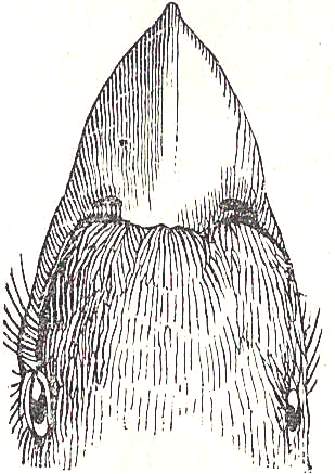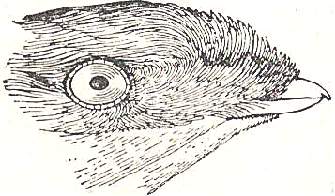
Picture of Broadbill's Bill (Eurylaimus)

Picture of Broadbill (Calyptomena)
|
The
Broadbill is a name which was appropriately (as can be seen by the diagrams)
given by Swainson in 1837 (Classification of Birds ii. p. 80), for
a remarkable group of birds comprising what was then the genus Eurylaemus
of
Horsfield (Trans. Linn. Soc.
xiii. p. 170) and some allied forms.
The position of this group, which was in 1842 recognized by Baron de Selys-Longchamps
as forming a good Family of its own, Eurylaemidae (now generally
spelled Eurylaimidae),
had long been doubtful, some authors regarding
it as allied to the
Muscicapidae (FLY-CATCHER), others to the Coraciidae
(ROLLER),
and so forth.
However, the Eurylaimidae, differed, from
all other PASSERES (so far as they had been examined at the time),
in "their retention of a plantar vinculum," as first noticed by Garrod
(Proc. Zool. Soc. 1877, p. 449), which fact led. W. A. Forbes to
propose for them further separation as Desmodactyli (op. cit. 1880,
p. 390). But what seems to be a stronger reason for separating them
is that, as Mr. Sclater had already shown (Ibis,
1872, p. 179),
the manubrium, or anterior projection of the sternum, is not forked as
in other PASSERES.
In modern 21st Century times, the Broadbills
or Eurylaimidae are established as a family of their own , and comprises
9 genera, within which around 14 different species of Broadbill exist.
Two of these, the Long Tailed Broadbill (Psarisomus dalhousiae)
and
the Silver-Breasted Broadbill (Serilophus lunatus), are found
in India. The style of plumage in the Silver-Breasted Broadbill
recalls that of
Ampelis (WAXWING), but no affinity thereto can be
thought to exist. They are nearly all birds of great beauty,
and the three species of Calyptomena, The Green Broadbill
(Calyptomena viridis), Hose's Broadbill, (Calyptomena hosii)
and Whitehead's Broadbill (Calyptomena whiteheadi) are remarkable
for their rich green plumage, and the way in which the frontal feathers
project upwards and forwards, so as almost to conceal the bill, and being
adpressed form a disk-like prominence.
Broadbills are frugivorous, but members of the
genus Eurylaimus seem to be insectivorous. They are said to be relatively
unintelligent birds, and usually keep in small flocks. As well as
being found in the elevated part of India and extending to the Philippines,
a few species can also be seen in Africa. Examples of other broadbills
occur in countries further to the east, and populations are especially
developed in Malacca, Java, Sumatra, and Borneo.
|





